This very sturdy tree fern grows natively from the Bay of Plenty and Waikato south. It was especially valuable up until the early nineteenth century as the source of rat-proof lining for pātaka kai (food-storage houses). Its fibrous trunks were excellent insulation, highly resistant to penetration by both damp and rats. It is also one of the "ghosts of Gondwana" -- tree ferns of this kind have been growing in Aotearoa for over 300 million years. This species is endemic to Aotearoa, but has close relatives in Indonesia, Malaysia, the Philippines, New Guinea. Eastern Australia, Fiji, Western Polynesia and Central and South America.
The trunk proper is relatively slender, but it is covered with a thick layer of densely matted aerial roots which make up 80% or more of its bulk. It is clothed in a thick mantle of spent fronds which stay attached to the trunk for many years and give the tree a distinctive appearance. This has the advantage of preventing epiphytic plants from attaching themselves to the upper part of the trunk of a growing tree, especially as the fibrous stem provides an ideal environment for epiphytes to attach themselves. The mature tree reaches a height of about six metres, about the same as its close relative, the whekī, but shorter than some of the other New Zealand tree ferns like the mamaku, Sphaeropteris medullaris, which reaches heights of 15 metres or more. It is a very versatile plant, which seems to grow well both in the interior of swampy forests and on exposed hillsides.It is found in open scrubland, forest margins and sometimes in forest interiors, and its appearance is much less affected by sun and wind than most other tree ferns. Brownsey and Smith-Dodsworth (NZ Ferns and Allied Plants, p. 83) note that the whekī-ponga is "The only tree fern that tolerates open country reasonably well".
The whekī-ponga is also one of the few tree ferns that has been established in outdoor settings in the warmer maritime parts of England, Ireland, southern Europe and the United States.
The fronds may be up to 2.5 m. long by 60 cm wide, with very short stipes, and up to 30 or more "live" ones forming the crown. Like the other Dicksonias, the stipes (stems) of the fronds are hairy (unlike the other set of New Zealand tree ferns, the Cyathea family, which have small scales covering the stipes). The fronds persist for a long time, and are aranged in alternating tiers of fertile and infertile fronds. They tend to be produced in bursts; the photo of the crown in the gallery was taken before the usual burst of fronds in late Spring; the photograph of the same tree in the summer (above) shows a more luxuriant crown than that of the same tree (12 years later) at the end of winter (below). The sori (clusters of sproagnia -- the spore-bearing organs) are on the margins of the leaves and protected by cup-shaped shells containing 3-6 sporagnia (those on the whekī have up to 12 sporagnia).
The whekī-ponga normally has a single trunk, which can reach 2 metres in diameter on very old trees (they may live for more than 200 years). They sometimes develop forked stems. These come out at an acute angle from the original trunk and then grow parallel to it. H.B. Dobbie notes that these plants were particularly common in some patches of forest near Tauranga (New Zealand Ferns, p. 128-9). He also notes that Dicksonia fibrosa and D. squarrosa may take a long time to reach maturity: those planted in his garden in Whangarei had not yet produced spores at 14 and 11 years old respectively. The tree in te Māra Reo photographed for this page had produced fertile fronds ten years after it was planted as a young plant whch already had a trunk. Twelve years later it had grown only as many centimetres taller and slightly increased its girth.
Like the whekī and the ponga, if planted promptly the felled trunks, with the fronds cut back or removed, will take root and grow. The plant is also easily grown from spores. It occasionally forms hybrids with the whekī, but this is not common. Tree ferns are attacked by a number of fungi and bacteria; the Armillaria fungus in particular can be a serious problem for the whekī-ponga; it attacks the roots and the lower part of the trunk; eventually it will kill the tree.
Because the visible "trunk" is actually a very thick blanket of aerial roots, when the fronds do fall off or are removed, the lower parts of the stipes do not persist as a sheath covering the trunk, as they do in the whekī. The bare "trunk" is a favourite medium for horticulturalists needing suitable material to use for attaching some epiphytic species of orchids and bromeliads. In recent years the trunks of the whekī-ponga have also become a favourite medium for garden sculptures.
It is interesting to note that despite the continued utility and economic importance of the whekī-ponga as a horticultural plant, medium for art work, and source of fibre for specialist growing media etc., there is very little detailed information about this species on the web, and most references in the literature are rather cursory, with its treatment by H.W. Dobbie (NZ Ferns), Large and Braggins (Tree Ferns), and Brownsey and Perrie (Flora of NZ: Dicksoniaceae) being notable exceptions. It seems to be one of those plants whose value is implictly recognized but seldom attracts explicit attention!
A NOTE ABOUT THE TAXONOMY OF TREE FERNS
When I was checking the current validity of the names of the tree fern species in the list of cognate terms and reflexes of the Proto-Polynesian words, I came across several conflicts which greatly delayed the production of this page but enabled me to learn a lot more about the evolution and classification of these plants than when I started. To make a very long story short, I can report that for the last 220 years botanists have been discussing the most appropriate classification of the major groups of tree ferns and their close relatives. Agreement has not yet been reached.
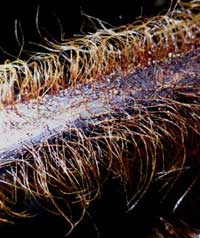 The current consensus among New Zealand and Cook Island botanists (as represented by the NZ Plant Conservation Network and the Cook Islands Natural Heritage Trust databases) recognizes two tree-fern families in our parts of Polynesia: Cyatheaceae, the scaly tree ferns (Ponga, Mamaku and 5 other related species in Aotearoa, all in the genus Cyathea -- see photo, below, right), and those without scales, Dicksoniaceae (Whekī, Whekī-Ponga and 1 other, in the genus Dicksonia -- photo on the left). (By "tree fern families" here is meant plant families most of whose members have trunk-like caudices or stolons. There are other families a few of whose members develop trunk-like stems; the species concerned may be called tree ferns, but the families are not classified that way.) The current consensus among New Zealand and Cook Island botanists (as represented by the NZ Plant Conservation Network and the Cook Islands Natural Heritage Trust databases) recognizes two tree-fern families in our parts of Polynesia: Cyatheaceae, the scaly tree ferns (Ponga, Mamaku and 5 other related species in Aotearoa, all in the genus Cyathea -- see photo, below, right), and those without scales, Dicksoniaceae (Whekī, Whekī-Ponga and 1 other, in the genus Dicksonia -- photo on the left). (By "tree fern families" here is meant plant families most of whose members have trunk-like caudices or stolons. There are other families a few of whose members develop trunk-like stems; the species concerned may be called tree ferns, but the families are not classified that way.)
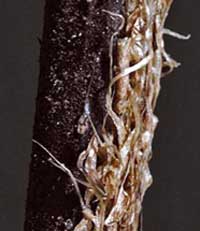 A widely-accepted alternative classification, as reflected for example in the World Flora Online database, divides the genus Cyathea into three or four separate genera, placing the Mamaku in the genus Sphaeropteris, and the other New Zealand species in the genus Alsophila. In other analyses, including it would seem that currently accepted in Aotearoa, these would be sections of the genus Cyathea, not genera in their own right. The Cook Island species are similarly apportioned in the WFO analysis: Cyathea affinis and C. decurrens are assigned to Alsophila, and C. parksiae to Sphaeropteris. A widely-accepted alternative classification, as reflected for example in the World Flora Online database, divides the genus Cyathea into three or four separate genera, placing the Mamaku in the genus Sphaeropteris, and the other New Zealand species in the genus Alsophila. In other analyses, including it would seem that currently accepted in Aotearoa, these would be sections of the genus Cyathea, not genera in their own right. The Cook Island species are similarly apportioned in the WFO analysis: Cyathea affinis and C. decurrens are assigned to Alsophila, and C. parksiae to Sphaeropteris.
A FURTHER NOTE ON TAXONOMY OF TREE FERN SPECIES. A few months after this page was revised in 2022, and shortly after Te Māra Reo Kawerongo #3 was sent out, a decision was made that the NZPCN database should adopt a revised taxonomy for these plants following the publication of several comprehensive DNA and taxonomic studies overseas. The New Zealand tree ferns formerly placed under Cyathea were reassigned to the re-established genera Sphaeropteris (C. medullaris) and Alsophila (all the rest -- with the former C. dealbata being re-named A. tricolor).
The main additional consequential changes required for this web site are: Cyathea parksiae becomes Sphaeropteris parksiae; Cyathea truncata a.k.a. Alsophila truncata becomes Sphaeropteris truncata; Alsophila rugosula is merged with and replaced by Sphaeropteris lunulata; Cyathea decurrens becomes Alsophila decurrens; Cyathea affinis becomes Alsophila tahitensis; also Angiopteris commutata becomes Angiopteris evecta. The genus Cibotium is shifted from the Dixoniaceae to a separate family, Cibotiaceae. These changes will be made page by page as time permits.
The reasons for these changes are outlined in Kawerongo #3 and #4. It should also be noted that these changes are not universally regarded as necessary. If you search for the generic name Alsophila on the Atlas of Living Australia website, for example, you will get this message:
genus: Alsophila R.Br. (accepted name: Cyathea)
Similarly, the botanists at Te Papa Tongarewa (Museum of New Zealand) prefer to regard Cyathea as a single genus, with Alsophila, Sphaeropteris and Cyathea s.s. as subgenera or divisions of the larger grouping.
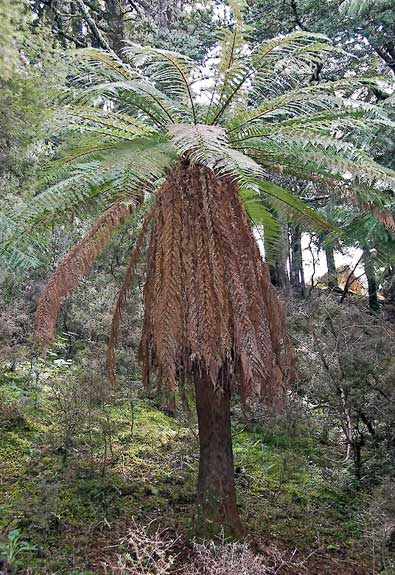
Dicksonia fibrosa - Whekī-Ponga
(Eastern Wairarapa, Aotearoa. Photo: (c) Jeremy Rolfe, NZPCN) |
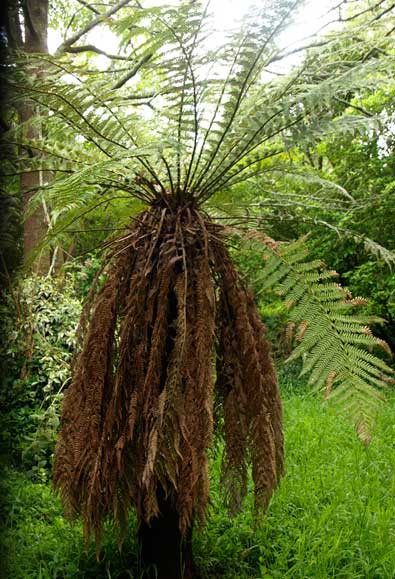
Dicksonia fibrosa - Whekī-Ponga
(Te Māra Reo, 2022. Same tree
as in right-hand photo at top of page, before Spring growth.) |
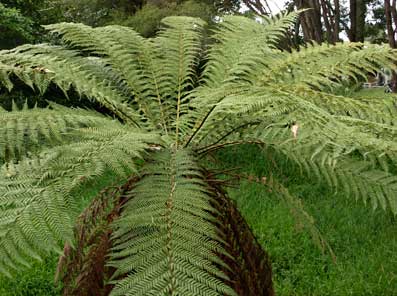
Dicksonia fibrosa - Whekī-Ponga
(Crown with fronds fully expanded. Te Māra Reo.) |
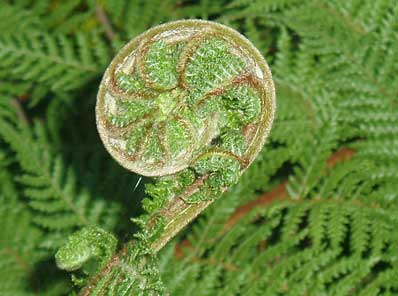
Dicksonia fibrosa - Whekī-Ponga
(Koru, about to unfold. Te Māra Reo.) |
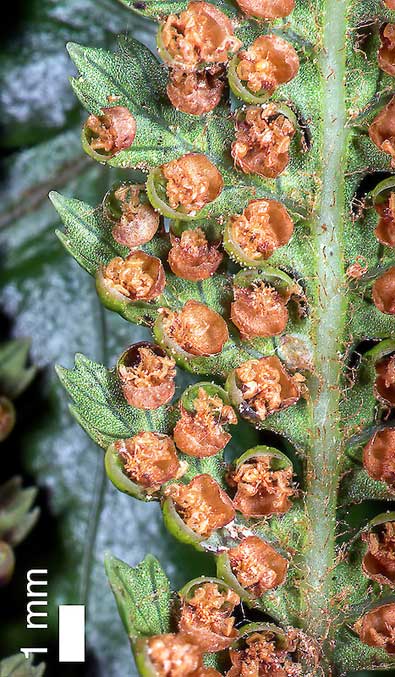
Cloose-up of sori of Dicksonia fibrosa - Whekī-Ponga
(Rangaika, Chatham Islands. Photo: (c) Jeremy Rolfe, NZPCN.) |
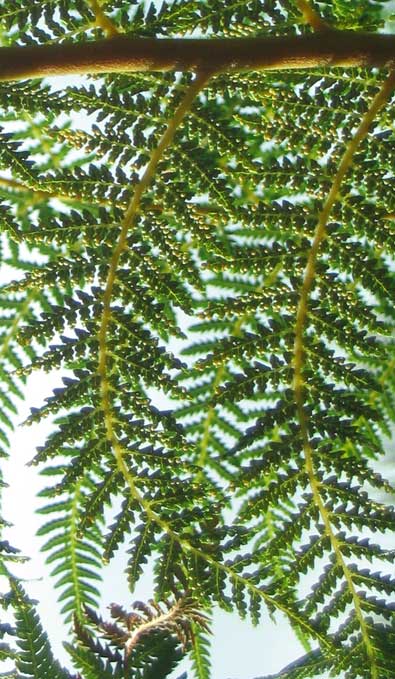
Pinnules (leaflets) of Dicksonia fibrosa - Whekī-Ponga - frond,
showing sori on margins.. Te Māra Reo) |
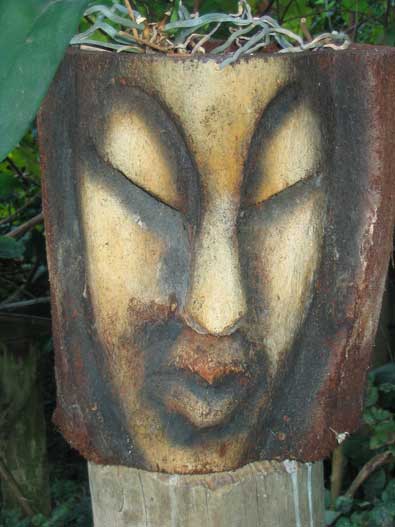
An orchid pot sculpted from the "trunk" of
Dicksonia fibrosa - Whekī-Ponga |
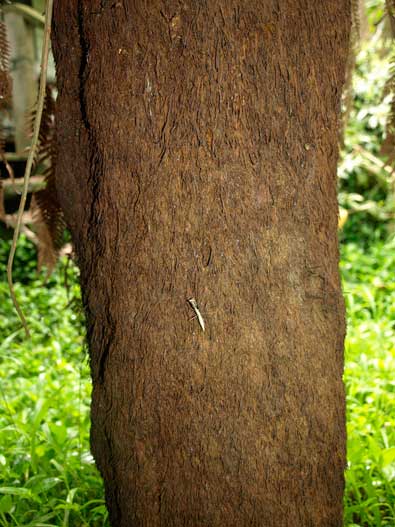
Dicksonia fibrosa - Whekī-Ponga
(Lower part of trunk.Note the praying mantis! Te Māra Reo.) |
|

